
Painted by Jean Fouquet (1458).
Philippa of Catania, also known Philippa the Catanian or Filippa Catanese (died in 1345), was a Sicilian woman of low birth who became an influential figure in the royal court of the Kingdom of Naples.

Philippa of Catania, also known Philippa the Catanian or Filippa Catanese (died in 1345), was a Sicilian woman of low birth who became an influential figure in the royal court of the Kingdom of Naples.
Born in Catania, Philippa was a local fisherman's daughter. [1] [2] Boccaccio, who met her when she was already an elderly woman, noticed that she was "attractive in manner and appearance". [2] She worked as a washerwoman when Robert, Duke of Calabria —son of Charles II, King of Naples —invaded Catania in 1328. [2] His wife, Violante of Aragon, accompanied him to the military campaign. [2] After discovering her pregnancy, Violante had to hire local staff and she chose Philippa as wet nurse for her son, Charles. [2] Philippa was a diligent servant and Violante brought her back to Naples after her husband had been forced to withdraw his troops from Sicily. [2]
Philippa was married off to Raymond de Campagne, a former slave of Ethiopian origin. [1] [3] Being Charles II's favorite and a successful military commander, Raymond had become one of the wealthiest landowners in the Kingdom of Naples. [3]
Philippa and her granddaughter, Sancia de' Cabanni were accused of participating in the murder of Andrew, Duke of Calabria. [4]

Joanna I, also known as Johanna I, was Queen of Naples, and Countess of Provence and Forcalquier from 1343 to 1382; she was also Princess of Achaea from 1373 to 1381.
Charles the Short or Charles of Durazzo was King of Naples and the titular King of Jerusalem from 1382 to 1386 as Charles II, and King of Hungary from 1385 to 1386 as Charles II. In 1381, Charles created the chivalric Order of the Ship. In 1383, he succeeded to the Principality of Achaea on the death of James of Baux.

The Kingdom of Naples, also known as the Kingdom of Sicily, was a state that ruled the part of the Italian Peninsula south of the Papal States between 1282 and 1816. It was established by the War of the Sicilian Vespers (1282–1302), when the island of Sicily revolted and was conquered by the Crown of Aragon, becoming a separate kingdom also called the Kingdom of Sicily. In 1816, it reunified with the island of Sicily to form the Kingdom of the Two Sicilies.

James II, called the Just, was the King of Aragon and Valencia and Count of Barcelona from 1291 to 1327. He was also the King of Sicily from 1285 to 1295 and the King of Majorca from 1291 to 1298. From 1297 he was nominally the King of Sardinia and Corsica, but he only acquired the island of Sardinia by conquest in 1324. His full title for the last three decades of his reign was "James, by the grace of God, king of Aragon, Valencia, Sardinia and Corsica, and count of Barcelona".

Francis I of the Two Sicilies was King of the Two Sicilies from 1825 to 1830 and regent of the Kingdom of Sicily from 1806 to 1814.
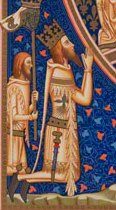
Louis I, also known as Louis of Taranto, was a member of the Capetian House of Anjou who reigned as King of Naples, Count of Provence and Forcalquier, and Prince of Taranto.
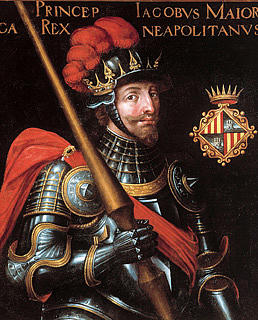
James IV of Majorca, also known as Jaume IV unsuccessfully claimed the thrones of the Kingdom of Majorca and the Principality of Achaea from 1349 until his death. He was also the king consort of Naples, but was excluded from the government.

Andrew, Duke of Calabria was the first husband of Joanna I of Naples, and a son of Charles I of Hungary and brother of Louis I of Hungary.
Isabella of Majorca (1337–1406) was the last titular Queen of Majorca and Countess of Roussillon and Cerdanya from 1375 to her death.

The War of the Sicilian Vespers or just War of the Vespers was a conflict that started with the insurrection of the Sicilian Vespers against Charles of Anjou in 1282 and ended in 1302 with the Peace of Caltabellotta. It was fought in Sicily, Catalonia and elsewhere in the western Mediterranean between the kings of Aragon on one side against the Angevin Charles of Anjou, his son Charles II, the kings of France, and the Papacy on the other side. The war resulted in the division of the old Kingdom of Sicily; at Caltabellotta, Charles II was confirmed as king of Sicily's peninsular territories, while Frederick III was confirmed as king of the island territories.

Maria Isabella of Spain was an infanta of Spain and queen consort of the Two Sicilies by marriage to Francis I of the Two Sicilies.
Robert of Durazzo was the third son of John, Duke of Durazzo and Agnes de Périgord.

The Capetian House of Anjou or House of Anjou-Sicily, was a royal house and cadet branch of the direct French House of Capet, part of the Capetian dynasty. It is one of three separate royal houses referred to as Angevin, meaning "from Anjou" in France. Founded by Charles I of Anjou, the youngest son of Louis VIII of France, the Capetian king first ruled the Kingdom of Sicily during the 13th century. Later the War of the Sicilian Vespers forced him out of the island of Sicily, leaving him with the southern half of the Italian Peninsula — the Kingdom of Naples. The house and its various branches would go on to influence much of the history of Southern and Central Europe during the Middle Ages, until becoming defunct in 1435.

Maria Clementina of Austria was an Austrian archduchess and the tenth child and third daughter of Leopold II, Holy Roman Emperor and Maria Luisa of Spain. In 1797 she married her first cousin Prince Francis, Duke of Calabria, heir to the kingdoms of Naples and Sicily. She was modest, well educated and kind, becoming popular in her adoptive country. Afflicted with frail health, she died of tuberculosis, age twenty four. Her only surviving child was Princess Caroline, Duchess of Berry.
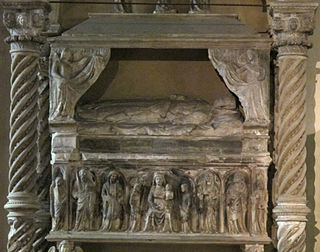
Maria of Calabria, Countess of Alba, was a Neapolitan princess of the Capetian House of Anjou whose descendants inherited the crown of Naples following the death of her older sister, Queen Joanna I.
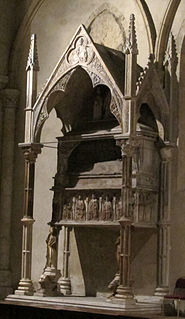
Marie of Valois, was the eldest daughter of Charles of Valois by his third wife Mahaut of Châtillon. She was a member of the House of Valois. One of her five children was Queen Joanna I of Naples.
Yolanda of Aragon was the daughter of Peter III of Aragon and Constance of Sicily. She married Robert of Naples, but was never Queen of Naples since she died before her husband inherited the throne.
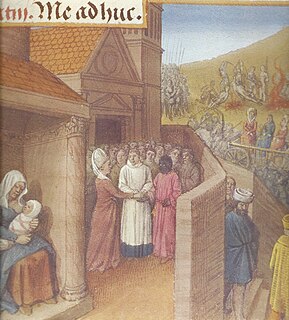
Raimondo de' Cabanni, also called Raymond of Campania, was a Neapolitan knight and courtier of black African origin. Through a combination of his own abilities and an advantageous marriage to one of the queen's inner circle, he rose through the ranks to hold the highest office in the royal household by the time of his death.